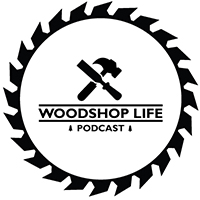This Episodes Questions:
Brian’s Questions:
Hey guys I have a kinda lengthy question, so new to woodworking and I’ve been listening to your guys podcast and really like it!! Very helpful! Question #1 is it better to have a good table saw blade over a good saw #2 is it better to have a good table saw over a good incra fence!? Back story I have a delta table saw, I got for free from a friend, I was wondering if it’s worth spending the money or save and eventually get a better saw like a powermatic table saw etc.
maybe I get caught up in the details of tools and expect them to do the work for me, but I am someone that like to have the right tools for the job. Granted as new as I am it’s hard to justify $10,000 to have all the right tools, just wondering if I should focus more on making something then, on the tools! Hope it all makes sense and it’s not more of a rant!! Thank you for all the work you guys do!! Ivan
I’m making a mantle for my living room out of rift-sawn white oak plywood. 74″ long, with a miter fold design. My wife wants it to look the same way it does before applying finish, and I’m not sure how to do that or if it is even possible. I’ve tested with water-based poly (Minwax), but it causes it to look a bit “golden”. Suggestions? Brian
Guy’s Questions:
Hi fellas,
Love the podcast and all your great advice.
I recently glued up a free-standing (liquor) cabinet and was very nervous about it being square, especially since it was difficult to check for square (measuring corner to corner in the front and back) with all the various clamps on. I ended up making the back panel (which fits into rabbets), which I knew was square, and placed it in the back (without glue) while the glue dried on the various joints (through tenons on top and bottom shelves, mid-shelves sit in stopped dados). The idea was that if the square back panel fit correctly, it would help pull the whole cabinet into square.
It turned out perfectly this time (wahoo!), but am not sure if I got lucky or if this is a reliable method to come back to. What do y’all think? Does this method make sense? Any other suggestions on how to check or ensure square with free-standing cabinets of a decent size (46″ tall, 26″ wide, 16″ deep)?
Thanks, Bryan
Hi gents: long time listener here and as I’ve said before, thanks so much for the great content you deliver. You have discussed your spraying equipment set up in the past but I was hoping you could describe your spray BOOTH set up- obviously Brian is exempt from this question since he doesn’t apply finish. How do you guys spray volatile finishes in the winter on your garage? Do you have a spray booth like set up? Do you openly spray in your garage workshops? How do you vent potentially dangerous fumes? Any details you can provide would be appreciated as I would like to do more spraying of shellac and I like wipe on poly both of which are challenges in winter time when you can’t work outside.
Liam from Indianapolis
Huy’s Questions:
I’ve recently found the podcast and am loving going back and learning from each episode! I’ve noticed that a ton of time has been dedicated to doling out wisdom on different types of finishing techniques and products. I’m sure the best way to learn all of this is through experience, but do you have and resources to recommend budding woodworkers as a go-to guide? With the way my brain works, learning the origins of each finish, their make-ups, and how that brings about their use cases and strengths/weaknesses would go a long way for me to internalize all of the various do’s and dont’s. Do you have a resource you go to when considering applicable finishing materials on a new project? Jeremiah
Love the show, I appreciate you guys giving it the time it takes to make it happen.
My question is about a solid Walnut table that I built for my eat in kitchen. The material was 30yr + air dried Walnut milled down to a thickness of about 15/16″ for the table top each board is six to eight inches in width and makes up a 32″ wide table top by 5′ and change in length. I used Domino’s for alignment titebond two for the glue. The table base is inspired by conoid table style from Nakashima and is connected to the table top using “buttons and screws” connected to the two rails at top each of the splayed legs. I did not add any type of support down the center nor any type of skirting or an apron so there’s about four foot in between the table legs of unsupported table top. – I’ve been using table for a few months now, and every once in a while I’ll place my Veritas straight edge on it and check. It hasn’t seemed to move at all in any direction but yet I still think about this multiple times a week what are your thoughts? Will this eventually sag in the middle with out a continuous support running the center if the table? Joe R.
